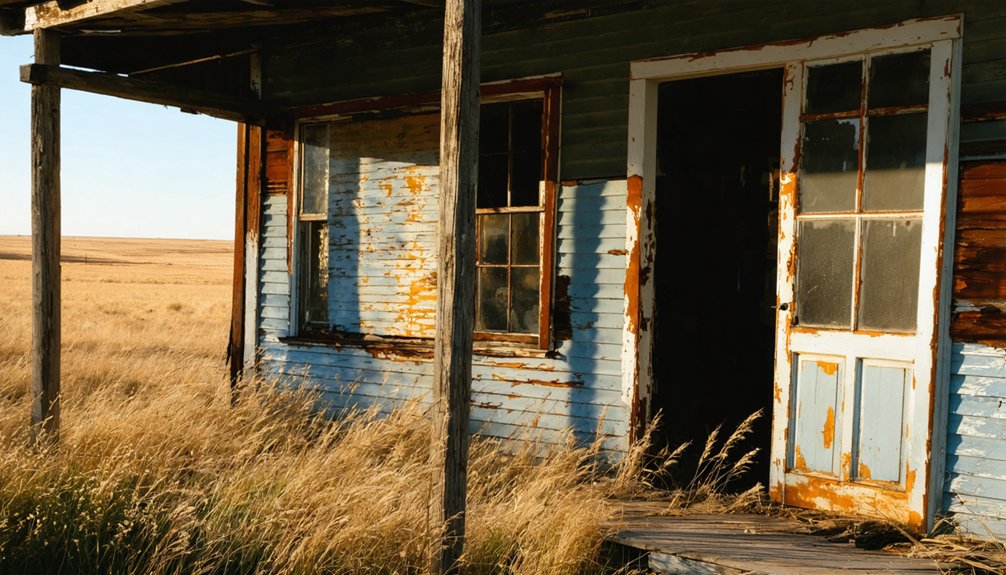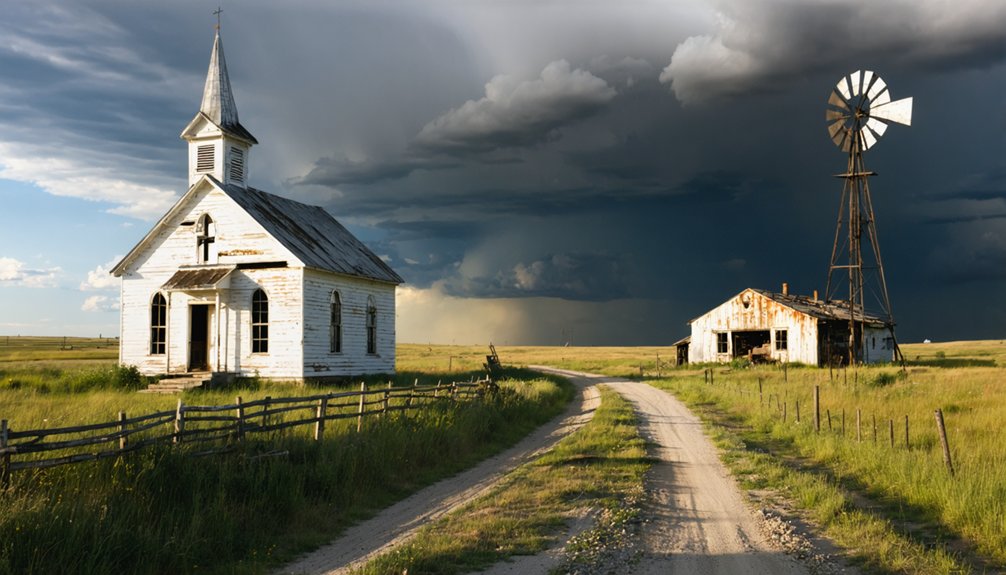You’ll find Marietta among South Dakota’s most mysterious ghost towns, established along historic railroad routes that serviced steam locomotives every seven miles. While the South Dakota State Historical Society maintains maps and photographs, its precise coordinates remain elusive on modern maps. Local legends tell of 30 stage robberies in 1880 alone, and the town’s mining operations left archaeological traces. The deeper story of this abandoned settlement holds surprising revelations about South Dakota’s industrial past.
Key Takeaways
- Marietta was established along railroad routes at seven-mile intervals to service steam locomotives during South Dakota’s early development.
- Archaeological evidence and foundations remain to be investigated, though the town’s precise location is difficult to pinpoint on modern maps.
- The town experienced 30 stage robberies in 1880, indicating significant criminal activity during its mining settlement period.
- Local historical societies maintain oral histories and land ownership documents tracking Marietta’s transition from settlement to abandonment.
- The South Dakota State Historical Society preserves maps and photographs of Marietta, though significant documentation gaps exist.
The Search for Historical Records
How do historians piece together the story of Marietta, South Dakota? You’ll find the answers scattered across multiple historical repositories, where dedicated researchers work to uncover the town’s historical significance.
The South Dakota State Historical Society maintains extensive documentation, including maps and photographs that reveal Marietta’s past. You can access vital information through the Archaeological Research Center‘s annual record searches and the scholarly articles published in *South Dakota History*.
Similar to many communities established along the railroad routes, Marietta emerged as one of the settlements positioned strategically every seven miles to service steam locomotives. Like hundreds of other ghost town remains in the Black Hills, careful investigation is needed to locate its foundations and structures. To trace Marietta’s development, you’ll need to examine old mining claims, post office records, and Sanborn maps showing building locations near Terry.
Record preservation efforts by local historical societies have safeguarded valuable oral histories from pioneer descendants, while land ownership documents help track the town’s change from active settlement to abandonment.
Geographic Mystery in South Dakota
Tracing the exact location of Marietta, South Dakota presents a compelling geographic puzzle for historians and explorers alike. Unlike its better-documented neighbor towns like Rockerville and Mystic, Marietta’s precise coordinates remain one of the region’s most intriguing geographic anomalies.
While you’ll find it’s accessible via local roads, mainstream maps often fail to pinpoint its exact position. The area shares similarities with Deadwood, as both communities experienced a nefarious gold rush period that shaped their destinies. Like the William Root House in Georgia’s Marietta, the site carries an aura of historical mystery that draws curious visitors.
Hidden from modern cartography, this ghost town’s true location remains a local secret, reached only by weathered backroads.
For urban exploration enthusiasts, the town’s physical remnants offer tantalizing clues. You’ll discover foundations, ash heaps, and occasional ruined structures that dot the landscape, marking where this once-vibrant community stood.
Modern hiking trails, often following old railroad grades, can lead you near the site. These paths preserve the physical layout of the region’s transportation network while hinting at the town’s historical relationship to nearby mining settlements.
Local Legends and Oral Traditions
While Marietta’s exact location remains elusive, its local legends paint a vivid picture of life in this former mining settlement. You’ll find that local ghost stories about this forgotten town often blend with typical miner folklore, though specific details remain scarce due to limited documentation.
The isolation of Marietta likely contributed to unique tales passed down through generations of South Dakotans. Stories often mention the town’s reputation for its 30 stage robberies in 1880 alone.
Like many ghost towns, Marietta’s oral traditions may have included accounts of mining discoveries, environmental challenges, and interactions with Native American tribes.
Similar to Cottonwood’s fate, the town faced a severe population decline after World War II.
You might hear whispers of why the town was suddenly abandoned, with stories ranging from resource depletion to natural disasters.
These legends, while difficult to verify, serve as valuable cultural artifacts that help preserve the memory of this vanished community.
Maps and Documentation Challenges
Despite extensive ghost town documentation across South Dakota, locating Marietta on modern maps presents significant challenges for researchers and historians.
You won’t find it on major interactive ghost town maps like Geotab’s database, and it’s absent from official state tourism resources. These mapping challenges extend to popular platforms like Google Maps and OpenStreetMap, which don’t reliably mark the town’s historical location. Many abandoned locations have no remaining traces of the original settlements.
Documentation gaps further complicate research efforts. You’ll discover that primary sources aren’t digitized, and the state’s online archives offer minimal information about Marietta. South Dakota’s Lawrence County alone contains 93 ghost towns, yet many remain poorly documented.
Limited digitization and sparse online records create significant barriers for those researching Marietta’s history in South Dakota’s archives.
If you’re seeking detailed information, you’ll need to rely on print materials, specialized map CDs, or direct visits to local archives. The lack of precise coordinates and boundary information makes it difficult to pinpoint the exact location of this vanished settlement.
Archaeological Evidence
Through extensive field studies, archaeologists have documented significant remains of Marietta’s salt mining operations near the dried Teels Marsh area.
You’ll find remnants of processing plants, foundations, and scattered mining debris that tell the story of this industrial site from the late 1800s. Archaeological findings include specialized equipment used in salt extraction and borax processing, initiated by F.M. “Borax” Smith.
Excavation techniques combine map analysis and field exploration to uncover building foundations, ash heaps, and industrial artifacts.
While the region’s broader archaeological record includes Paleoindian stone tools and spear points, Marietta’s archaeological significance centers specifically on its salt mining heritage.
The site’s unique industrial footprint distinguishes it from typical ore-mining ghost towns in the Black Hills region.
Ghost Town Registry Findings
You’ll find limited official documentation about Marietta in South Dakota’s ghost town registries, despite its classification as a barren site in Fall River County.
The town’s shift to the Tubbs Gravel Pit has left few historical records to confirm its peak population or exact dates of operation.
Similar to other completely vanished towns in South Dakota, no buildings or structures remain at the former Marietta site.
While the site meets the criteria for ghost town status based on its complete abandonment and lack of structures, many key details about Marietta’s founding, development, and decline remain unverified in state records.
Like many mining boom towns across South Dakota, Marietta’s story represents the cyclical nature of frontier settlement and abandonment.
Missing Historical Records
While exploring South Dakota’s ghost town records, you’ll find significant gaps in historical documentation that challenge researchers and historians. The historical significance of these lost records becomes evident as you investigate the Black Hills region, where over 600 ghost towns once thrived with bustling communities and economic activities.
You’ll encounter archival challenges when researching towns like Marietta, as many documents have been lost or remain unorganized. The South Dakota State Archives offers extensive resources, but you’ll discover that thorough records for numerous sites simply don’t exist.
While well-documented towns like Spokane provide detailed insights into past community life, many other locations remain shrouded in mystery. The State Historical Society continues working to preserve what records remain, making them accessible through their digital collections for your research needs.
Status Remains Unconfirmed
Despite extensive research efforts, Marietta’s ghost town status remains unconfirmed in South Dakota’s official registries and historical records.
You’ll find that determining Marietta’s classification is challenging due to mixed reports and incomplete documentation of its ghost town characteristics. The site’s current condition and occupancy indicators aren’t clearly documented in available records.
- Registry protocols require on-site verification, but seasonal access restrictions may limit physical assessment.
- Reports conflict between Nevada and South Dakota locations, creating confusion about which Marietta is referenced.
- Occasional inhabitants or caretakers might be present, complicating traditional ghost town classification.
- Available sources lack recent authoritative surveys that would confirm whether the site is barren, neglected, or abandoned.
Research Methods and Sources

Researching the ghost town of Marietta requires a systematic approach drawing from diverse historical sources.
You’ll need to investigate digital archives maintained by the South Dakota State Historical Society, which house essential records, photographs, and demographic data about the town’s development and decline. The archival preservation of government reports, land records, and period newspapers provides significant primary documentation.
To build a thorough understanding, you’ll want to examine oral histories, census data, and post office records that reveal population trends.
Population records tell a story through time – from census tallies and mail routes to the voices of those who lived there.
Contemporary resources like Travel Nevada and regional history publications offer additional context. For visual documentation, explore YouTube videos and photographic surveys of remaining structures.
Cross-referencing multiple sources helps verify historical facts and separate documented events from local legends.
Frequently Asked Questions
Was Marietta’s Name Inspired by a Specific Person or Another Town?
You can’t definitively determine Marietta’s name origins or historical significance, as available records don’t conclusively link the town’s name to any specific person or place in South Dakota’s past.
Did Any Native American Tribes Inhabit the Area Before Marietta?
Where there’s smoke, there’s fire – you’ll find that Native tribes, particularly the Sioux (Dakota, Lakota, Nakota), inhabited the region long before Marietta’s establishment, holding deep cultural significance across these grasslands.
Were There Any Natural Disasters That Affected the Town?
You won’t find reliable records of major natural disasters affecting the town. While the Black Hills region faced floods and droughts, there’s no documented flood damage or drought impact specifically hitting Marietta’s community.
What Type of Climate and Vegetation Existed in Marietta’s Location?
You’d find a continental climate with harsh winters and hot summers. The area supported mixed-grass prairie vegetation, featuring drought-resistant grasses like blue grama, while trees only grew near streams.
Did Any Famous Outlaws or Historical Figures Pass Through Marietta?
You won’t find any confirmed outlaw sightings or historical legends here – available research shows no evidence of famous outlaws or notable figures passing through this small South Dakota settlement.
References
- https://travelnevada.com/ghost-town/marietta-ghost-town/
- https://www.youtube.com/watch?v=Glucs_Rq8Xs
- https://www.sdpb.org/rural-life-and-history/2023-08-21/some-black-hills-ghost-towns-and-their-origins
- https://www.powderhouselodge.com/black-hills-attractions/fun-attractions/ghost-towns-of-western-south-dakota/
- https://www.southdakotamagazine.com/a-ghost-town-called-spokane
- https://icatchshadows.com/okaton-and-cottonwood-a-photographic-visit-to-two-south-dakota-ghost-towns/
- https://aberdeenmag.com/2019/01/the-ghost-towns-of-brown-county/
- https://en.wikipedia.org/wiki/List_of_ghost_towns_in_South_Dakota
- https://www.youtube.com/watch?v=4l09mo9p3hY
- https://www.sdhspress.com/journal/south-dakota-history-2-2/some-black-hills-ghost-towns-and-their-origins/vol-02-no-2-some-black-hills-ghost-towns-and-their-origins.pdf



